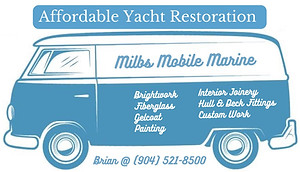
9610 Commonwealth Ave., Jacksonville, FL 32220
Sanding Biscuit's Boom (1-26-25)
Jan 26, 2025
After a few days out of town celebrating my son's sixth birthday, I returned to the shop to take down the heat lamp inside the well pump house and return the paint and epoxy (the shop is not climate controlled). We've had some unusually cold temps descend upon us in Florida. After resetting the shop, I got straight to the boom. The outhaul fitting remained on the boom, having been sitting after receiving a good shot of PB Blaster and wrapped in plastic. A few taps with the phenolic hammer yielded no results. My next play was to insert a length of black walnut into the boom, an off-cut from a countertop I had made, striking it to push out the outhaul fitting. After several hits, I checked the fitting and saw no movement. One of the fasteners had sheered off in the process of extracting it with the impact driver. I thought perhaps a portion of the stainless steel fastener was impeding my desired goal, so I decided to tap the holes for 10-32 machine screws - just slightly larger than the existing fasteners. With the three holes freshly tapped, and clear of whatever was remaining in the holes, I returned to the pounding of the black walnut off-cut. With a couple taps, pop!, out went the outhaul fitting. Finally, the boom was back to a blank tube; however, I was bummed to see a small portion of the outhaul fitting broken off and remaining fused to the inner lining of the boom. I thought instantly of replacing the outhaul, but the more I thought it through the more I was inclined to clean up the surfaces of the broken portions and fuse back with epoxy resin. The combination of the epoxy resin and new fasteners would serve as an adequate repair for this fitting and save the owner an $80 part (this might change at owner's discretion).
The tube was ready for sanding, as prep for paint....actually, etching with phosphoric acid, application of a primer, and then painting. Both the mast and boom will undergo this treatment, and with the dropping temperatures as of late, I decided to begin the process on the boom. I used the palm sander and also hand-sanded the boom. The palm sander, with 80-grit discs, was good to break up the surface of the clear anodized tube. I then followed the rough sanding with the hand work - a combination of 40, 60, 80, and 120 grit discs to get to the desired sheen. It was good to have this done, as I can now order materials for painting the boom (and mast) and new fittings for reassembly.
Total Hrs: 3





